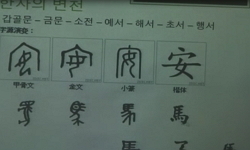A Study on Seo Myeng-Eung's 『Sun-Chen-Sa-Yeon』 CHO, HIE-YOUNG Department of Philosophy Graduate School Soongsil ...
http://chineseinput.net/에서 pinyin(병음)방식으로 중국어를 변환할 수 있습니다.
변환된 중국어를 복사하여 사용하시면 됩니다.
- 中文 을 입력하시려면 zhongwen을 입력하시고 space를누르시면됩니다.
- 北京 을 입력하시려면 beijing을 입력하시고 space를 누르시면 됩니다.
https://www.riss.kr/link?id=T12643673
- 저자
-
발행사항
서울: 숭실대학교 대학원, 2011
-
학위논문사항
학위논문(박사)-- 숭실대학교 대학원: 철학과 2012. 2
-
발행연도
2011
-
작성언어
한국어
- 주제어
-
DDC
181.1146 판사항(21)
-
발행국(도시)
서울
-
기타서명
A Study on Seo Myeng-Eung's 『Sun-Chen-Sa-Yeon』
-
형태사항
332p: 삽도; 26cm.
-
일반주기명
숭실대학교 논문은 저작권에 의해 보호받습니다.
지도교수:곽신환
참고문헌: p. - 소장기관
-
0
상세조회 -
0
다운로드
부가정보
다국어 초록 (Multilingual Abstract)
A Study on Seo Myeng-Eung's 『Sun-Chen-Sa-Yeon』
CHO, HIE-YOUNG
Department of Philosophy
Graduate School
Soongsil University
This thesis studies on the content of 『Sun-Chen-Sa-Yeon(先天四演)』written by Seo Myeng-Eung(徐命膺, 1716~1787). 『Sun-Chen- Sa-Yeon』generally contains his studies and ideas and it is in the head of 『Bo-Man-Jae-Chong-Seo(保晩齋叢書)』by his works in his lifetime. His study was named by Sun-chen study whose origin was Shao Yong(邵雍, 邵康節, 1011~1077) and it was continued by Chu Hsi(朱熹, 1130~1200) and Cai Yuan-ding(蔡元定, 1135~1198). In『Sun- Chen-Sa-Yeon』, Seo Myeng-Eung explains the reason of heaven and ground through the Sangsoo(象數) in 「Ha-Do(河圖)」which is a picture for Sun-Chen and Moo-Moon-Ja-Yeok(無文字易),「Sun-Chen -Sa-Do(先天四圖)」「8Gue-Do(8卦圖)」「Bang-Wi-Do(方位圖)」「Cha-Seo-Do(次序圖)」and「Bang-Won-Do(方圓圖)」. ‘Sun-Chen(先天)’ means that the time the pure energy of nature is plentiful and all are achieved. It also means the world that human nature has natural appearance like Fu His(伏羲) period. In the Hoo-Chun[後天, reality] for approaching Sun-Chen, the behavior of people(凡人) is 'In-Eui-Ye-Ji(仁義禮智)' based on the character of nature(自然性).
‘Sun-Chen-Sa-Yeon' means that Sun-Chen is interpreted and deduced by four methods. The four methods are ‘Earn-Sang-Soo-Eui(言-象-數-意)’ and it was called by Sun-Chen-Sa-Do(先天四道). In ‘Earn-Do(言道)’, it's mentioned by 「Ha-Do」 ontology that 「Ha-Do」 is in the center of Sun-chen study. It regards 「Ha-Do」 as the ‘foundation of humanities manufacture’ and it is regulated by the place that 「Sun-Chen-Sa-Do」 was appeared at first. ‘Sang-Do(象道)’ explains astronomical calendar through the 「Bang-Won-Do」.
Seo Myeng-Eung regulated that 「Ha-Do」 is 'Hoik-Jun-Yeok(畫前易)' formed by only Yangui(兩儀) and Sasang(四象) and said that creation and change of all things cannot get out of the pattern of Yangui and Sasang. If examining ‘Soo-Do(數道)’, he is a person of logical soo theory (理數論者) and person of soo basical theory that soo is advanced by sang. Seo Myeng-Eung divided all things of heaven and ground with Sa-Boo-Bub(四府法), widened to 16 sa, unfolded Yeok-Soo-Ron(易數論) and judged the history with Won-Hoi-Wun -Se(元會運世). The key words of Seo Myeng-Eung's theory in ‘Eui-Do(意道)’ are ‘中’ and ‘心’. 「Sun-Chen-Do(先天圖)」 said that 中(Middle, Center) is 心(Heart) and Tae-Keuk(太極) because all changes are occurred in the center, 中.
Seo Myeng-Eung created new conditions of Sun-Chen study(先天學) and opened new prospect. He suggested the point different from the existing Sun-Chen study and based on it, there is a comprehensive standpoint embracing other studies. Sun-Chen study entered new conditions with 'way to Sun-Chen' suggested by Seo Myeng-Eung and ‘「Ha-Do」 ontology’ established by him. The prospect opened in new conditions is appeared in changes of So-Gang-Jeol's 「Nae-Do(內圖)」. Seo Myeng-Eung solidified 「Ha-Do」 ontology through the changes of 「Nae-Do」 and created the space combined by Chun-Moon(天文) and 「Bang-Won-Do」. In the same context, the differentiation with existing ‘Ha-Rak-Ron(河洛論)’ is tried by changing Cai Shen(蔡沈)'s 「99 direction capital(99方數圖)」. He considered 「Oui-Do」 as the celestial bodies in 「Bang-Won-Do」, 「Nae-Do」 as the earth and 3 Geuk of Chun-Ji-In (天地人) as celestial bodies, so it reads I-Ching(易) dynamically. Seo Myeng-Eung interprets Daojia(道家) from the standpoint of Sun-Chen study(先天學) and shows open attitude to accept the Western astronomy passed at that time with Sun-Chen study.
Seo Myeng-Eung was close to royal family originated by Hanyang noble family and his periodical worry needed the method to respond the Western study flowed to Joseon(朝鮮). The academic system contains Rujia(儒家) and Daojia, leads periodical ideology of Joseon and leads the future. Seo Myeng-Eung discovered the solutions in Shao Yong's Sun-Chen-Yeok- Hak(先天易學) and interpreted it from the viewpoint of Joseon. Furthermore, he developed it to new system reflected by natural science and intended to prepare present and future. He is a Sang-Soo epidemiologist who unfolds Yeok-Ri(易理) with Sang(象) and Soo(數), but his point is concluded to loyalty. His Sim-Sung-Ron(心性論) is ‘中’ mind and ‘Goong-Ri-Jin-Sung(窮理盡性)’ reflected by ‘一事無’'s Sun-Chen ideology and it can be a goal that we must seek together. He insists that thought must be opened by regarding ‘中’ and ‘心’ as the best values. The reasons are that ‘中’ balances between all things and human by extremely high, ‘心’ relates among the human and makes ‘understanding and embracing’ possible and ‘openness of awareness’ guides human to the wide world. ‘中’ becomes humane capital if it is valued without abandonment and social capital if accumulating mutually with Sung-Sim(誠心). If reflecting on his study, it is greatly ‘study seeking and explaining the basis of heaven and ground’ and the method can be ‘seeing the world again after going back to the foundation[Ea-Mul-Kwan-Mul(以物觀物) and Ban-Kwan(反觀)]. However, it's urgent to 'communicate with philoso- phical point' by finding humanities and scientific factors that his Sun-Chen study has actually.
Key Words ; Sun-chen study(先天, 先天學), Fu His(伏羲), 「Ha-Do(河圖)」, Shao Yong(邵雍, 邵康節), 「Sun-Chen-Do(先天圖)」 , Sun-Chen- Sa-Do(先天四道-言象數意), 中(Middle, Center), 心(Heart)
국문 초록 (Abstract)
서명응의 『先天四演』에 관한 연구 哲 學 科 조 희 영 指導敎授 곽 신 환 본 논문은 徐命膺(1716~1787)이 지...
서명응의 『先天四演』에 관한 연구
哲 學 科 조 희 영
指導敎授 곽 신 환
본 논문은 徐命膺(1716~1787)이 지은『先天四演』의 내용을 연구하는 글이다. 『선천사연』은 그의 학문과 사상을 총괄적으로 담고 있는 저서이며 생전에 그의 저작물을 엮은『보만재총서』의 권두에 있다. 그의 학문을 선천학이라 하며 그 유래는 邵康節(1011~1077)에서 비롯되고 朱熹(1130~1200)와 蔡元定(1135~1198)에 의해 이어졌다. 서명응이『 선천사연』에 주장한 내용은 ‘先天’에 관한 그림이자 無文字易인 「河圖」와「先天四圖」인「8卦圖」「方位圖」「次序圖」「方圓圖」에 나타난 象과 數를 통하여 천지의 이치를 해명하는 것이다.
선천이란 자연의 순수한 氣가 넘치고 誠이 충만한 때를 의미하는데 그것은 伏羲時代처럼 인간의 본성이 그 자연적 모습을 간직한 세상을 말한다. 선천에 도달하기 위한 後天[현실]에서 凡人의 행위는 自然性에 기초한 ‘仁義禮智’이다. ‘선천사연’이란 선천을 네 길로 해석하고 연역한다는 뜻이다. 그 네 길은 ‘言-象-數-意’이며 이를 先天四道라 했다.
‘言道’에서 서명응은 「하도」를 선천학의 중심에 두는 「하도」 본체론을 언급한다. 「하도」를 ‘인문제작의 근본’으로 보고 있으며 「先天四圖」의 생출처로 자리 매김한다. ‘象道’에서는 「방원도」를 통하여 천문역법을 해명한다. 서명응은 「하도」는 兩儀와 四象으로만 이루어진 ‘劃前易’으로 규정하고 만물의 생성변화는 양의와 사상의 패턴을 벗어날 수 없다고 했다. ‘數道’를 보면 그는 理數論者이자 동시에 數가 象에 앞선다는 數 根本論者임을 알 수 있다. 서명응은 四府法으로 천지만물을 분류하고 16事로 넓혀가면서 易數論을 전개하고 원회운세로 역사를 재단한다. ‘意道’에 나타난 서명응 사상의 핵심은 ‘中’과 ‘心’이다. 「선천도」는 그 가운데인 中에서 모든 변화가 일어난다고 하며 中은 心이자 태극이라 했다.
선천학은 서명응이 제시한 ‘선천으로 이르는 길’과 그가 수립한 ‘「하도」 본체론’으로 이전과는 다른 모습을 드러내고 있다. 이러한 국면은 특히 소강절의「내도」변형에서 나타난다. 서명응은 「내도」 변화를 통해서「하도」본체론을 공고히 하고 天文과 「방원도」가 결합할 공간을 창출해 낸다. 같은 맥락에서 蔡沈의「99방수도」를 변형하여 기존의 ‘하락론’과 차별화를 시도한다. 그는 「방원도」에서 「외도」를 천체로 보고 「내도」를 지구로 보며 天地人 3極을 천체로 재해석하는 등 역동적으로 易을 읽어낸다. 또한 서명응은 선천학의 관점으로 道家를 해석하고 당시 전래한 서양천문학도 선천학으로 수용하려는 개방적 자세를 보여준다.
이와같이 그는 기존 선천학에 변화를 시도하고 타 학문을 포섭하는 통섭적 자세로 독자적인 학문 체계를 수립하는 동시에, 선천학의 새로운 경지를 열었다고 할 수 있다. 서명응은 한양 명문 출신의 왕실 측근으로 그의 시대적 고민은 조선에 유입된 西學에 대응하고, 儒家와 道家를 포괄하면서 조선의 시대사상을 주도해 나갈 학문적 사상적 체계였다. 그는 그 해결책을 소강절의 선천역학에서 발견했고 이를 조선의 시각으로 재해석했으며, 더 나아가 자연과학을 반영한 새로운 역학으로 발전시켜 현재와 미래에 대비하려 했다.
서명응은 象과 數로 易理를 전개하는 상수역학자이지만 그의 논지는 義理로 귀결된다. 그의 心性論은 自然之事인 ‘一事無’의 선천사상이 반영된 ‘中’의 마음과 ‘窮理盡性’인 바 그것은 우리가 더불어 추구해야 할 덕목이라 할 수 있다. 서명응은 ‘中’과 ‘心’을 최고의 가치로 여기고 思考가 탁 트여 있을 것을 주장한다. 그 이유는 ‘中’은 至高至極하여 만물과 사람의 사이에서 ‘균형’을 잡아주고, ‘心’은 인간 사이를 서로 연결하여 ‘이해와 보듬기’가 가능하며, ‘인식의 트임’은 사람을 넓은 세상으로 안내하기 때문이다. ‘중’은 그것을 버리지 않고 귀히 여기면 인간적 자본이 되고, 誠心으로 서로가 쌓으면 사회적 자산이 된다.
그의 학문을 돌이켜 보면 크게는 ‘천지의 존재 근거를 추적하여 해명하는 학문’이고 그 방법은 ‘근본으로 돌아가 세상 다시 보기(以物觀物하고 反觀하기)’라 할 수 있다. 그러나 현실적으로는 그의 선천학이 품고 있는 인문과학적 요소를 찾아서 ‘철학적 논제와 회통하기’가 시급한 과제라 할 수 있다.
주제어 ; 선천(학), 복희,「하도」, 소강절,「先天圖」, 先天四道(言象數意), 中, 心
목차 (Table of Contents)
- 목 차
- 國 文 抄 錄 ⅵ
- 英 文 抄 錄 ⅸ
- 목 차
- 國 文 抄 錄 ⅵ
- 英 文 抄 錄 ⅸ
- 제 1 장 緖論 1
- 1.1 연구목적 1
- 1.2 先天과 四演 4
- 1.2.1 선천의 意義 4
- 1.2.2 四演과 四道 20
- 1.3 선행연구 검토 및 논문 구성 28
- 제 2 장 言道論 35
- 2.1 「河圖」 중심 선천학 38
- 2.2 「先天圖」의 구조 해명 41
- 2.2.1 「선천도」의 생성 과정 41
- 2.2.2 「次序圖」의 구조 46
- 2.3 「方圓圖」의 원리와 함의 51
- 2.3.1 「방원도」의 구성 원리와 互卦生出 52
- 2.3.2 「방원도」의 順逆論 65
- 2.3.3 三十六宮 天根月窟과 陰陽交變 78
- 제 3 장 象道論 87
- 3.1 「하도」와 획전역 89
- 3.1.1 지혜의 단초 「하도」 89
- 3.1.2 획전역과 선후천역 93
- 3.2 선천학과 曆法의 결합 100
- 3.2.1 남북극 兩儀와 經緯의 새로운 해석 101
- 3.2.2 「방원도」의 卦氣疏密 110
- 3.2.3 易象과 干支天象 119
- 3.3 天圓地方論과 地圓說 131
- 제 4 장 數道論 143
- 4.1 數 根本思想과 「하도」 147
- 4.1.1 수 근본론과 중궁수 147
- 4.1.2 乘除法과 「하도」 155
- 4.2 64方圓數와 乾坤坎離 160
- 4.3 「방원도」와 元會運世 166
- 4.4 16事數와 易數論 182
- 제 5 장 意道論 194
- 5.1 「하도」 中宮과 太極 196
- 5.1.1 中과 太極의 상관성 196
- 5.1.2 「하도」 중궁과 坎離 205
- 5.2 변화의 원점으로서의 中 208
- 5.2.1 「차서도」의 中과 변화 208
- 5.2.2 「방원도」의 中과 변화 211
- 5.3 선천학의 심성론 218
- 5.3.1 ‘一事無’와 中思想 218
- 5.3.2 蓍策과 선천의 뜻 223
- 제 6 장 선천학의 지평 확장 231
- 6.1 선천학의 新局面 조성 231
- 6.1.1 선천에 이르는 길과 「하도」 본체론 수립 231
- 6.1.2 64괘로부터 8괘 추출 236
- 6.2 선천학의 새로운 論點 제시 241
- 6.2.1 「내도」 변형으로 「방원도」 재평가 241
- 6.2.2 주희․채원정의‘河洛論’과 차별화 259
- 6.2.3 易學 해석의 새로운 방법 273
- 6.3 선천학의 통섭적 자세 279
- 6.3.1 선천학으로 『參同契』해석 279
- 6.3.2 서양천문학의 선천학적 수용 284
- 제 7 장 結 論 297
- 참고문헌 306












